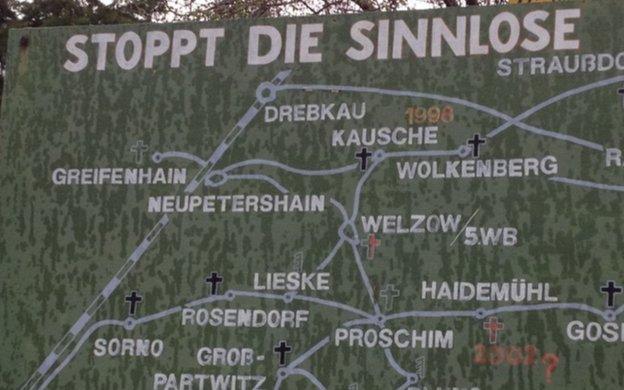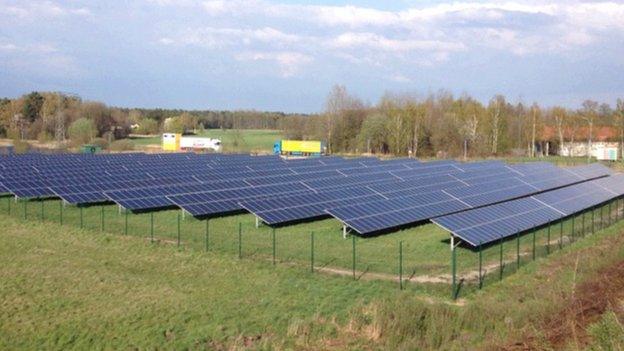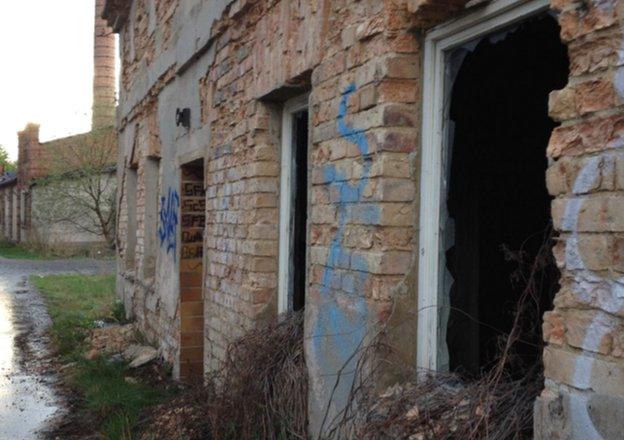Germany's green dreams meet harsh reality
- Published
- comments
David Shukman takes a look at the massive scale of Germany's coal-mining operation
A vision for a greener future for the world seems very distant if you descend into the heart of one of Germany's largest coal mines.
While researchers and officials are in Berlin preparing the next report from the UN's Intergovernmental Panel on Climate Change, the country's fossil fuel industry is as busy as ever.
The report is expected to set out options to switch from sources of energy that give off the greenhouse gas carbon dioxide to cleaner types like wind and solar.
This mirrors Germany's own ambitions with a plan known as the Energiewende, best translated as "energy transition", which calls for at least 80% of power to come from renewable sources by 2050.
But south of Berlin in the region of Lausitz, down at the coal face in a mine called Welszow-South, machines the size of office blocks gouge out chunks of lignite and low-carbon dreams hardly seem plausible.
The lignite, also known as brown coal, is one of the dirtiest, most polluting kinds of fuel, but it helps generate no less than 26% of Germany's electricity.
Add in the country's harder black coal as well and you find that nearly half of the country's electricity comes from the one source which climate scientists argue most needs to be phased out.
The challenge is that, for the moment, coal offers a relatively cheap and easy solution, there is plenty of it and thousands of jobs are involved so the mining enjoys robust support from unions and local politicians.

This protest sign is one example of the opposition to new mines
For a country that prides itself on showing green leadership, and hosting the IPCC meeting, the reliance on coal illustrates the sheer difficulty of turning visions into reality.
Germany is in the bizarre position of being the world's largest producer of solar power - and of lignite.
The dark cliffs of brown coal stretch for miles, exposed to the air for the first time since they formed from a swampy forest that lay along the shores of the North Sea 17 million years ago.
Ancient twists of branches, compacted and dusty, lie inside the coal, a reminder of a process that once sucked huge amounts of carbon dioxide out of the air, only for it now to be released back into the atmosphere.
The mine is one of several operated by the Swedish state-owned company Vattenfall and its managers are bullish about the prospects.
In addition to the lignite already earmarked for extraction, they say there are another 1.6 billion tonnes approved for future mining in this area alone and demand remains high.
The head of operations, Uwe Grosser, is polite about the "energy transition" and the advent of renewables but dismisses the idea of a future without coal.
"We're the only ones who deliver constant power. Our power is always there.

Germany is the world's largest producer of solar power
"When solar, wind and the renewables are fed into the grid we're the only ones able to adjust our output, that's the only way it's possible to prioritise renewables.
"If they can't provide power. We can. 24 hours a day. 365 days a year."
The last time I encountered Vattenfall was in very different circumstances: we were reporting on the construction of its huge wind farm off the coast of Cumbria.
Here the process of extracting coal has been fine-tuned over the past century. First, one of the largest moveable machines on the planet - a staggering 500m long - eats away at the layers of sand and silt to reveal the lignite.
The drivers are just visible perched in cabs high above the ground as they rearrange the geology.
Then comes the extraction of the lignite itself, a giant wheel grinding through the seam, sharpened scoops each carrying the weight of a small car in coal.
On the horizon stands a power station fed by the lignite, a mix of water vapour and exhaust rising from its towers. This is a region whose history is intertwined with that of coal and unpicking that will be no easy feat.
Patrick Graichen of the think-tank Agora-Energiewende, which seeks to build consensus on energy, concedes that the future of coal has so far been side-stepped.
"It is a tough challenge because politicians have so far only been focused on the phasing out of nuclear and the phasing in of renewables.
"We didn't look at coal but that's what we need to do and that will be tough because a lot of regions depend on coal."

Many properties in the village of Haidemuehl have been bought up by Vattenfall
And, for the time being, the demand for the coal as a power source gives the operators a massive incentive for expansion.
The little village of Proschim stands in the path of one plan to open up a new mine.
Dozens of villages have been bulldozed in recent decades to make way for lignite mining but Proschim offers something special.
About 40 of its 120 houses are fitted with solar panels, wind turbines spin in the fields nearby and a farm enterprise has started turning agricultural waste into biogas.
A large poster proclaims the "Energiewende" and this is indeed a model of what the transition is meant to be about.
For Hagen Rosch, whose family have lived in the village for more than a century, the impending destruction of a model green village is the opposite of what the national government is seeking.
"This huge coal mine will destroy the nature, the village, the houses, the life of the people," he told me.
"And we produce green energy - we have solar panels and biogas. Coal is the old kind of engineering and the past will destroy the future in Proschim - this is terrible, this is crazy."
So while the UN climate panel maps out greener options, and Germany tries to put that vision into practice, Proschim could become a test-case, its demolition or survival a pointer to the future.